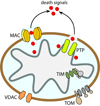The therapeutic potential of mitochondrial channels in cancer, ischemia-reperfusion injury, and neurodegeneration
- PMID: 21406252
- PMCID: PMC3410559
- DOI: 10.1016/j.mito.2011.03.003
The therapeutic potential of mitochondrial channels in cancer, ischemia-reperfusion injury, and neurodegeneration
Abstract
Mitochondria communicate with the rest of the cell through channels located in their inner and outer membranes. Most of the time, the message is encoded by the flow of anions and cations e.g., through VDAC and PTP, respectively. However, proteins are also both imported and exported across the mitochondrial membranes e.g., through TOM and MAC, respectively. Transport through mitochondrial channels is exquisitely regulated and controls a myriad of processes; from energy production to cell death. Here, we examine the role of some of the mitochondrial channels involved in neurodegeneration, ischemia-reperfusion injury and cancer in the context of their potential as therapeutic targets.
Copyright © 2011 Elsevier B.V. and Mitochondria Research Society. All rights reserved.
Figures


References
-
- Altschuld RA, Hohl CM, Castillo LC, Garleb AA, Starling RC, Brierley GP. Cyclosporin inhibits mitochondrial calcium efflux in isolated adult rat ventricular cardiomyocytes. Am J Physiol. 1992;262:H1699–H1704. - PubMed
-
- Arnoult D, Rismanchi N, Grodet A, Roberts RG, Seeburg DP, Estaquier J, Sheng M, Blackstone C. Bax/Bak-dependent release of DDP/TIMM8a promotes Drp1-mediated mitochondrial fission and mitoptosis during programmed cell death. Curr Biol. 2005;15:2112–2118. - PubMed
Publication types
MeSH terms
Substances
Grants and funding
LinkOut - more resources
Full Text Sources
Medical

